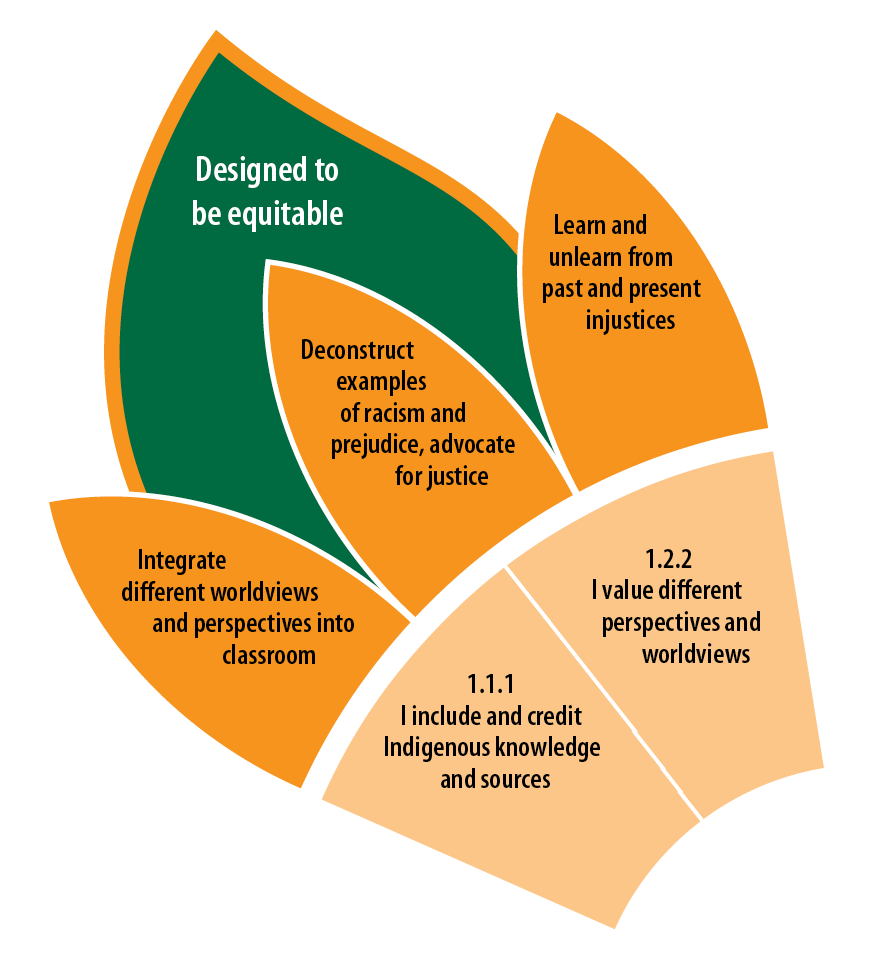Honouring Indigenous Knowledges in Higher Education
What are some ways to include and honour Indigenous Knowledge into our courses?
By Gwenna Moss Centre for Teaching and LearningThis article is sixth in a series about integrating EDI principles into our teaching and learning design and practices. It is a collaboration between Indigenous and non-Indigenous staff members.
‘I include and credit Indigenous knowledge and sources’ is one of the Designed to be Equitable indicators from USask’s EDI Flower and the Certificate for University Teaching (CUTL).
 |
Embracing the Designed to be Equitable principle means we actively include and cite Indigenous worldviews, emphasizing the importance of valuing diverse perspectives and worldviews. |
In considering this indicator, it is imperative, first, we enter this work with humility, identifying and confronting our biases and assumptions about Indigenous cultures and Peoples. Our awareness will help to address stereotypes and inaccuracies in textbooks, other educational materials, media and in our own communities. For more on the benefits of raising our awareness, see Positionality in the Classroom: An EDI Principle
Including Indigenous knowledge, worldviews, and perspectives is both crucial and beneficial for our students. The previous article suggested reasons for including and crediting Indigenous knowledge and sources.
Reflecting on our current knowledge and relationships and assessing our gaps is also necessary. We must consider how to incorporate Indigenous ways of knowing into our teaching if we have limited knowledge of Indigenous cultures and people in our community. Where do we start?
Strategies for learning about and inclusion of Indigenous knowledge and sources:
- Consult with Darryl Isbister, Lead, Indigenous Education Initiatives. Connect with those in your college/school who advise on Indigenous pedagogy.
- Build relationships with Indigenous Elders, Knowledge Keepers, scholars, and community members. Learn about the particular protocols needed to invite people to share their knowledge and experiences with students.
- Make contributions back to community. After receiving gifts of knowledge from individuals and communities, we must offer something of ourselves in return. What might you contribute?
- Locate Indigenous texts and resources. Include books, articles, and multimedia by Indigenous authors and creators in your courses, to provide students with authentic Indigenous voices and viewpoints. Ensure any resources are properly cited and credited.
- Learn from ohpahotân | oohpaahotaan (let’s fly up together), USask’s Indigenous Strategy, created by kēhtē-ayak (Elders), Traditional Knowledge Keepers and Language Teachers, and presented as a gift to the people of USask.
- Find out more about traditional Indigenous approaches to student-centred learning and how practices can influence your instruction and assessment. Consider, as examples, place-based learning, land-based learning, and other forms of experiential learning.
- Place-Based Learning – emphasis on local environment and community as learning context, aiming to nurture engagement and responsibility within the community, connecting curriculum to authentic issues and experiences.
- Land-Based Learning – centres on relationships between individuals and the land, rooted in Indigenous knowledge systems and practices with land as a teacher; involves hands-on experiences and seeks to foster deep connection to the land.
- Curriculum Integration – By embedding Indigenous perspectives into our courses, we make what we teach more inclusive, enriched, and decolonized.
Reference
- Indigenous Ways of Knowing Course Design, University of Calgary, Dr. Gabrielle Lindstrom (Tsa'piinak, Kainai Nation, Blackfoot Confederacy) and Lorelei Anselmo.
-----
This article series is a detailed exploration of the USask EDI Framework Principles and its application in course design and our classrooms.
- Empowering Education: Embracing Equity, Diversity, and Inclusion at USask
- Fostering Inclusive Learning Environments at USask: The EDI Framework for Action
- A Teaching Tool: The EDI Flower
- Positionality in the Classroom: An EDI Principle
- Designed to be Equitable: An EDI Principle
- Honouring Indigenous Knowledges in Higher Education (current article above)
- Crediting Indigenous Knowledge and Sources
The next article in this series looks at how to credit Indigenous knowledge and sources properly and respectfully, as guided by Indigenous authors, scholars and publishers.
7. Crediting Indigenous Knowledge and Sources
Title image credit: Jake Parkinson on Pixabay.com

